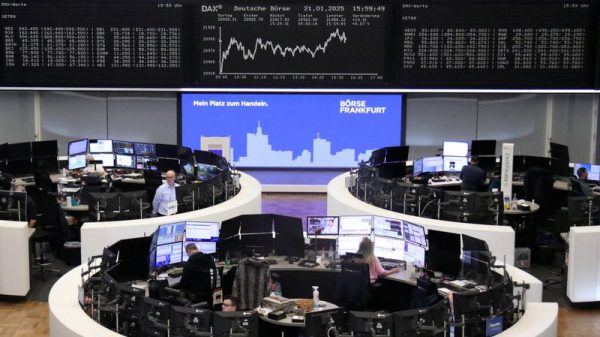In the recent earnings call for the third quarter of 2024, Canfor Corporation (TSX:CFP) CEO Don Kayne presented a mixed financial picture, with significant losses in the lumber segment but strategic moves aimed at long-term growth. The company reported a lumber business loss of $336 million, including a $100 million asset write-down, while the pulp segment remained resilient with an adjusted operating income of $2 million. Canfor is undergoing a strategic shift, closing operations in British Columbia due to challenges such as accessing viable fiber and increasing U.S. tariffs while expanding in Alberta, the U.S. South, and Europe.
Key Takeaways
Canfor’s lumber segment reported a $336 million loss, including asset write-downs.
The pulp segment showed resilience with a $2 million adjusted operating income.
Canfor is reducing its BC footprint, closing the Plateau and Fort St. John mills.
New facilities include a sawmill in Axis, Alabama, and the acquisition of Iron Mountain (NYSE:IRM) mill in Arkansas.
Canfor expects a challenging Q4 but remains optimistic about future market conditions.
Capital expenditures for 2024 are projected at $450 million for lumber and $50 million for pulp.
Interest rate drops could improve affordability and demand, especially in the multifamily segment.
Company Outlook
Canfor projects capital expenditures for 2025 to be significantly lower, estimated between $250 million and $300 million.
The company is optimistic about medium to long-term market conditions despite a challenging upcoming quarter.
Bearish Highlights
The closure of BC operations will remove over 1 billion board feet of annual production capacity.
The lumber business has been hit with substantial losses and asset write-downs.
Bullish Highlights
Canfor’s Kootenay operations are performing well, especially with specialty products.
The company is making major capital investments and closing high-cost operations to improve future prospects.
Misses
Canfor’s lumber business has faced significant challenges, reflected in the reported financial losses.
Q&A Highlights
CEO Don Kayne acknowledged the unpredictability of trade policies, such as potential tariffs under a future Trump administration.
Canfor has been active in strategic acquisitions, focusing on growth in Europe, Alberta, and the U.S. South.
Pulp production is expected to remain below 50% capacity due to line rationalization.
Canfor’s strategic focus is shifting in response to various market pressures, including the need to access economically viable fiber and mitigate the impact of U.S. tariffs. The company’s expansion into new regions is paired with the closure of less profitable operations, a move aimed at strengthening its long-term market position. Despite the current losses, Canfor’s management team expressed cautious optimism about future demand and opportunities, citing recent capital investments and strategic acquisitions as key factors in their positive outlook.
Full transcript – None (CFPZF) Q3 2024:
Operator: Good morning. My name is Joanna, and I will be your conference operator today. Welcome to Canfor and Canfor Pulp’s Third Quarter Analyst Call. All lines have been placed on mute to prevent any background noise. During this call Canfor and Canfor Pulp’s Chief Financial Officer will be referring to a slide presentation that is available in the Investor Relations section of the company’s website. Also, the companies would like to point out that this call will include forward-looking statements, so please refer to the press releases for the associated risks of such statements. I would now like to turn the meeting over to Mr. Don Kayne, Canfor Corporation’s President and Chief Executive Officer. Please go ahead, Mr. Kayne.
Don Kayne: Thank you, operator and good morning, everyone. Thank you for joining the Canfor and Canfor Pulp Q3 2024 results conference call. I’m going to make a few comments before I turn things over to Pat Elliott, our Chief Financial Officer of Canfor Corporation and Canfor Pulp and our Senior Vice President of Sustainability. In addition, we are joined by Kevin Pankratz, our Senior Vice President of Sales and Marketing. As you know, Canfor has been focused on building on his globally diversified operating platform by increasing our footprint in Alberta, the U.S. South and Europe, while maintaining a reduced presence in British Columbia. This quarter, we made some additional difficult decisions in British Columbia, announcing the closure of our plateau and Fort St. John operations in Northern BC. Combined with previous announcements, these closures will remove a 1 billion more feet of annual production capacity from our BC operations. These decisions were driven by the persistent challenge in accessing economically viable fiber in northern BC, which is not improving. This challenge was further exacerbated by the increase in U.S. tariffs, which are expected to double again next year. Despite the challenges in the BC Interior, our Kootenay operations continue to perform well, supporting our specialty product and value-added focus, including key high-margin products such as MSR, J-grade and home center grades. In Alberta, despite weak North American lumber pricing, our operations continue to provide positive earnings in Q3. In the U.S., South our focus was on executing on our capital plan. Today, our sawmill operations in our new facility in Axis, Alabama began production. When the planer mill is completed later this year, we expect the first shipment of finished lumber. The new sawmill will have an annual capacity of 250 million board feet on a two-ship basis. Our MOBILE plant ceased operations earlier this month with decommissioning being conducted throughout the remainder of 2024. The acquisition of the former Resolute El Dorado mill in Arkansas, now called Iron Mountain, was completed on August 1. The Urbana upgrade project is in its final phase with startup last month and ramping up production in Q4. This project will increase capacity to 285 million board feet. With respect to Vida, although our results were marginally better-than-expected, 2024 has been challenging with log costs continuing to increase. On our financial results, our lumber business in North America recorded significant losses in the third quarter, due to persistently weak lumber prices, increasing duties, and a lack of available economic fiber in British Columbia. Notwithstanding increasing log costs, combined with seasonal downtime, our European operations generated positive operating income in the third quarter. While global lumber demand remains tepid in the short-term, lumber prices have steadily increased over the last several weeks. With interest rates beginning to normalize, we anticipate affordability to gradually improve through 2025, which should support higher pricing into next year. While we anticipate a challenging fourth quarter we believe our lumber business is well positioned to capitalize on improving market conditions over the medium to long-term supported by several significant capital investments nearing completion in the U.S. South, closures of certain high cost assets across North America and our strong European platform. With respect to pulp, on an adjusted basis, our pulp business generated improved financial results in the third quarter, supported by higher sales realizations. Pulp production was modestly lower than the previous quarter with our Northwood mill successfully transitioning to a one-line operation in August. While Canfor pulp continues to navigate the uncertainty associated with fiber supply in British Columbia, we have seen improved operating results over the last several quarters and remain focused on improving our cost structure going forward. I will now turn it over to Pat to provide an overview of our financial results.
Pat Elliott: Thanks, Don, and good morning everyone. In my comments this morning I’ll speak to our third quarter financial highlights, a summary of which is included in our overview slide presentation located in the investor relations section of Canfor’s website. As Don mentioned, this was a challenging quarter with our lumber business generating an operating loss of $336 million. These results include an asset write-down and impairment charge of a $100 million, non-cash duty related adjustments of a $121 million and several other items recorded in the third quarter. Adjusting for these one-time items, our lumber business generated an operating loss of $129 million, compared to a similarly adjusted loss of $115 million in the prior quarter. These results continue to reflect the impact of weak North American lumber markets, particularly for Southern Yellow (OTC:YELLQ) Pine, as well as an elevated cost structure due to significant production curtailments in North America, seasonal downtime in Europe and losses associated with certain high-cost operations in British Columbia. We anticipate an improvement in our underlying cost structure following the orderly wind down of several BC sawmills later this year. In addition, with several major capital projects in the U.S. South nearing completion, we anticipate a gradual improvement in our unit cost structure as this low-cost capacity begins to ramp up throughout 2025. Turning to our pulp business. Canfor Pulp generated an operating loss of $209 million, including a $211 million asset write-down and impairment charge. On an adjusted basis, Canfor Pulp generated operating income of $2 million, an improvement of $7 million from the previous quarter, largely driven by improved pulp unit sales realizations. In total, we reduced the net book value of our lumber and full assets in BC by approximately $311 million, reflecting the rightsizing of our operating footprint and balance sheet as a result of recent closure announcements and the reduced availability of economic fiber supply in the province. At the end of the third quarter, Canfor Pulp had net debt of $68 million and $85 million of available liquidity, excluding a term loan commitment of $80 million related to a potential reinvestment in North [Technical Difficulty]. Canfor — excluding Canfor Pulp, and the $314 million duty deposit loan completed in late September, ended the third quarter with net cash of approximately $330 million. On a consolidated basis, capital expenditures were approximately $117 million in the quarter, including $18 million for Canfor Pulp. We anticipate capital spend of approximately $450 million in the lumber segment for ‘24, including the remaining spend on our Alabama greenfield, as well as various growth initiatives in the U.S. South and Sweden. We anticipate a significant reduction in our capital spend in 2025 following the completion of these 3 major projects. For Canfor Pulp, we are currently forecasting capital spend of approximately $50 million in 2024, including capitalized patents. In addition, we anticipate Canfor will continue to allocate a modest amount of capital to opportunistically repurchase shares. And with that, Don, I’ll turn the call back to you.
Don Kayne: All right. Thanks, thanks Pat. So operator, we’re okay now to take questions from analysts.
Operator: Thank you. We will now take questions from financial analysts. [Operator Instructions] Your first question comes from Ben Isaacson at Scotia Bank. Please go ahead.
Unidentified Analyst: Good morning. This is [Apurva] (ph) on for Ben. My first question is we’ve seen a bit of a general slowdown in European lumber imports. Wondering if you could comment on what Canfor’s volume out of the region looks like? And how much of that slowdown is due to North American imports versus domestic demand in Europe?
Don Kayne: Yes, thanks very much. Maybe, Kevin, you could comment on that.
Kevin Pankratz: Sure. Yes, thanks for the question. And yes, European imports are down, and that was largely predicated in slumping pricing here in North America that made it very competitive for many of the operators there. Our volume from Vida into North America was actually relatively stable quarter-over-quarter. And a lot of that is committed to program business and a bunch of that with the home center business. So I would say, because of that, our volumes are more stable, but the more I think transactional volume did see a shift.
Unidentified Analyst: Thank you. And then my second question, if I can sneak it in, is can you provide us any update on how the modernization of Urbana is going, as well as the greenfield and access? Roughly how much incremental capacity do you expect will come online this year? And then given kind of where market conditions are today, are you considering delaying or deferring any ramp-up?
Don Kayne: Yes. So first of all, on Urbana, it will be — we’ll be commissioning that in Q4 2024 for sure. And the spend there is about 93% completed so far. We’ve got a little bit more we need to spend there. The additional capacity is going to be about 115 million board feet.
Unidentified Analyst: Thank you.
Don Kayne: And for Axis. You mentioned Axis also. The capacity there, that’s also going to be complete. I think I mentioned in my comments that they’re starting that up. But if the capacity there will be 250 million board feet. And we’re about — basically that’s all we need to say on Axis for now.
Operator: Thank you. The next question comes from Ketan Mamtora at BMO Capital Markets. Please go ahead.
Ketan Mamtora: Good morning and thanks for taking my question. Maybe, Don, to start with, in general, I thought your release and your comments this morning are striking a pretty cautious tone in terms of near-term demand in lumber, some of the others that have reported are probably expecting a little more sort of recovery as we go through into Q4 and ‘25. I’m just curious as you look at your demand and what you are hearing from your customers, can you comment at all in terms of repair and remodeling demand, new residential demand, how that’s holding up and how that has trended through the quarter and into October? Thank you.
Don Kayne: So Ketan, thanks for the question, Ketan. I’ll maybe start real quick, and then I’ll pass it over to our sales and marketing guru here, Kevin. But first of all, just really on demand, I think we are cautious, but we become cautious in the last couple of three years, right? We — while we’ve been — we’ve done a fair bit of traveling lately in the United States and even in Japan, and overall, I think demand looks fairly stable, actually, it doesn’t look — it’s not disappointing us in any way. We’re just being cautious for any major uptick at this time. And more believe a lot of the increase that we see will come from a supply reduction as opposed to demand increases. But overall, we’re certainly not negative at all. Ketan, as a matter of fact, looking forward, we’re actually quite positive. And I’ll let Kevin talk about that in more detail.
Kevin Pankratz: Actually, I mean, the outlook actually looks a bit promising there, and we are we are a little bit cautious. However, with the state — we had some major interest rate drops and a lot of our customers believe that, that trend is going to continue, which is going to help address affordability. And I guess it’s just a question of timing. And once that affordability threshold gets achieved, I think the demand unlock is going to be pretty good. And more specifically, talk like multifamily, that’s been a big segment that’s been underperforming. And we’re starting to see that, that has actually bottomed and that could help demand down the road. But those are longer-term projects that take time to get done versus a single family. So that’s why we’re a little bit cautious going into Q1 of 2025, but we do share that view that demand actually looks promising, but really, the uplift in pricing today has been largely driven by supply reductions.
Ketan Mamtora: Got it. That’s helpful context. And then, Pat, one for you. You mentioned you expect a pretty meaningful reduction in 2025 CapEx for lumber order of magnitude. How should we be thinking about that sort of reduction? Just rough numbers?
Pat Elliott: Yes, Ketan. We’re fine-tuning still what I’d say it’s like $250 million to $300 million versus the $450 million we spent this year. That would be the range I’d use.
Ketan Mamtora: $200 million to $250 million, Pat, is that what you said for lumber?
Pat Elliott: $250 million to $300 million.
Ketan Mamtora: I see, okay. Got it, perfect. That’s all I had. I’ll turn it over. Good luck.
Pat Elliott: Thanks.
Operator: Thank you. Next question comes from Sean Steuart at TD Cowen. Please go ahead.
Sean Steuart: Thanks. Good morning, everyone. A couple of questions. Pat, I’ll start with the loan against the duty receivable hoping you can give us some of your rationale there given you already have a strong balance sheet, and it looks like the borrowing costs, depending on the time frame here could be reasonably high. I guess the read-through is either you’re expecting this is going to be a very drawn out process towards any sort of resolution on the trade file or do you feel the need to bolster an already strong balance sheet ahead of maybe a difficult market environment or ahead of potential M&A opportunities. Can you give us some more context on the rationale, Pat or Don, on that front?
Pat Elliott: Yes, sure, Sean. I mean you’re right, there’s a timing call in there for sure. I think on both sides of the equation. I can’t tell you when this will settle. We’re not — we’re on the record as sort of identifying. We don’t see a near-term settlement. Canfor has over $725 million on deposit. And with the rates increasing here at 16% and then probably doubling or more again next year, we’re going to have a lot more on deposits. So for us, the opportunity to take some of the money off the table even at a discount seem to make some sense. There’s no specific use of funds we have in mind, but just the flexibility and these opportunities maybe don’t come along all the time. It took us a while to do it. And so while it was there, we thought it was sort of prudent to take sort of 40% of our current exposure off the table. And that’s how we came to do it now, Sean.
Sean Steuart: Okay. Understood. Second question is on European fiber costs. You mentioned the pressure you’ve seen on that front, and we’ve seen reports that [Indiscernible] in Sweden is increasing log costs again, I suppose, over the last week or so. Can you speak to the general fiber cost environment, your ability to recoup that in local prices for lumber with the quarterly contract system that seems to be more in place there? I suppose just general comment on fiber costs in Europe?
Don Kayne: Yes. I mean I think you phrased that well. I mean, I think that it’s safe to say across Europe, the fiber costs have increased pretty dramatically from a fairly low base, though to start with, but still they have definitely increased, and Northern Europe, particularly have increased. I guess there is some offset there, though, in terms of quality of the fiber that we get there. And as you know, and we’ve spoken about it before, we have a very, very high percentage of high-value product opportunities there that we’ve been able to develop over years and long before we came along, even Vida was focused on that before. So we’re in BC, we’re in Canada, even in the U.S., were 40% to 60% high value there is more like 80%, 90%. So significant recovery, a great recovery improvements in Sweden, compared to anywhere else really in the world, probably, but certainly at the top of the list there. And the other thing there too, Sean, is we built our flexibility of markets. We have the ability to move around to where the markets are at the highest value as well. And even though log costs have gone up, we certainly have — we’re certainly never comfortable with increases, but we’ve got lots of options and with a high value percentage of our portfolio, feel good about that, too.
Sean Steuart: Okay, that’s great detail. Thanks, Don. That’s all I have for now.
Don Kayne: Yes. All right. See you.
Operator: Thank you. Next question comes from Hamir Patel at CIBC Capital Markets. Please go ahead.
Hamir Patel: Hi, good morning. Don, I wanted to get your thoughts on how much of the capacity that’s been removed this year is kind of gone for good versus just maybe idle for a period of time and at risk of coming back in a stronger market. And just thinking specifically in the U.S. South?
Don Kayne: Yes. Good question. It’s one that we wrestle with ourselves, right? And ourselves, we’ve just speak in a counter we got a couple of mills down and had kind of half one back kind of thing. But at the end of the day, hard to know the reason it’s difficult is a lot of the independents, right? They don’t report, they don’t speak about it, but we can only tell by the performance in the last 12 to 18 months of the Southern Yellow Pine operations overall, that they’ve got to be under significant pressure. So our belief is it’s definitely down. If you go back, we talked about the plot, if you went back two, three years when a lot of these larger mills, the 15 big mega mills that everybody has built through that bid construction, there is expected to be significant increases scale up by production, which, of course, this year, year-to-date, it’s probably down 7%, 8%. So it’s not anywhere near what was expected even a couple of years ago. So our view is that together is, whether — how much of that is permanently down hard to tell. But I would say that there’s a portion of that for sure is, just hard to get a complete handle on. But safe to say, though, I think that we’re not going to see anywhere near the increases that we thought we would have seen based on forecast a couple of years ago.
Hamir Patel: Fair enough. And Don, how do you think about euro, your European exports to the U.S., just given the rationalization you’ve done to your BC platform. Do you expect that to grow? And maybe you could speak to the relative attractiveness of selling into the U.S. from Europe versus selling domestically?
Don Kayne: Yes. I think there’s — that’s one of the reasons why we diversify like we did. We wanted to be able to — we’ve anticipated the BC situation for a long time, because of beetle and fires and everything else that you hear, trade issues and everything else. So that’s why we invested in other markets to start with. So certainly, Vida gives us some options there for sure. So we’re looking at that in terms of what those are and can be going forward. So yes, there is a part to play from our view for Vida, and that’s already underway in a lot of cases already. I know Kevin has been working on a lot of programs there already to supplement what we get out of Alberta, particularly in British Columbia. So yes, so I think if you had to look at our — that acquisition and what we believe to be the case in terms of capitalizing on that diversification, I think that’s planned as we thought it would — as the way we thought it would.
Hamir Patel: Great. Thanks. And just the last question I had was dependent, obviously, with the U.S. upcoming election, if we were to have another Trump administration and that he’s talked about putting sort of across the board 10% tariff on imports. Is there any reason lumber would not also get hit with that additional 10% if that occurs? I’m just thinking with the ongoing trade dispute? And is that maybe risk that your duties, which already are going to go up potentially even more?
Don Kayne: With all due respect, Hamir, I think it’s obviously a really, really difficult one to call because there’s a lot of — it seems like weekly, and annually, we get a little surprises on that subject, but hard to speculate at this point on that I mean obviously, just like the you and the duties that we’re dealing with today, you’ve got price responses and timing and all of that. So really difficult one to answer at this point.
Hamir Patel: Okay. Fair enough. That’s all I had all. I’ll turn over. Thanks.
Don Kayne: All right. Thanks, Hamir.
Operator: Thank you. Next question comes from Matthew McKellar at RBC Capital Markets. Please go ahead.
Matthew McKellar: Good morning. Thanks for taking my questions. Can you talk a bit about what you’re seeing across the landscape for acquisitions in Wood Products today, both in North America and Europe, please?
Don Kayne: Yes. I mean just from our standpoint, I mean, we certainly have been pretty active in the last three or four or five years in terms of acquisitions in strategic geographies that we felt was important future and that combined now with some of the capital projects that we’ve done with the two new greenfields and the pretty extensive brownfield that we’ve done in Urbana, overall, clearly, we’re continuing to look at opportunities in Europe, and there’s lots of opportunity, I think, all over the place. But we — right now, we’re just been real, real focused on completing the capital that we’ve got in place with those as we go out the startups that are forthcoming here. And we’ll continue to look at opportunities as they look forward. There’s nothing that I can speak to at this point at all. But you’ve heard us talk before, and this still the case that we like Europe, we really like Alberta, and we really like the U.S. South.
Matthew McKellar: Okay, thanks for that.
Don Kayne: And we’ll never like the cookies.
Matthew McKellar: Okay, thank you. And then just one more cleanup for me on CapEx. I think I heard $250 million to $300 million on the lumber side next year. Are you expecting on the pulp side, ’25 looks something like ’24? Or any comments around that, please?
Pat Elliott: Yes. Matthew, I think given that we’ve rationalized the line at Northwood, we’ll be below 50%. We’re still working through that, but I anticipate it being below 50%.
Matthew McKellar: That’s helpful. Thank you. I’ll turn it back.
Pat Elliott: Thanks, Matthew.
Operator: Thank you. We have no further questions. I’ll now turn it over to Don Kayne for closing comments. Go ahead, Mr. Kayne.
Don Kayne: Great. Thanks, operator, and thanks, everyone, for participating this morning. We appreciate you tuning in, and we look forward to talking to you at the end of Q1. Thank you.
Operator: Ladies and gentlemen, this concludes your conference for today. We thank you for participating, and we ask that you please disconnect your lines.
This article was generated with the support of AI and reviewed by an editor. For more information see our T&C.




























